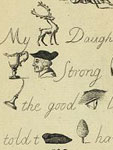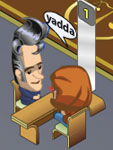 In DIHR? the player manages a legal firm specializing in constitutional law. The player first selects whether to do the "Full Edition" of rights throughout the Constitution or "Bill of Rights" which focuses on rights within the first 10 Amendments. He or she then customizes their lawyer and chooses a partner lawyer who specializes on a right. The game takes place over seven rounds, each representing a day. In each round the player tries to earn as many prestige points as possible for the firm by taking on clients and winning their cases. This involves a three-step cycle.
In DIHR? the player manages a legal firm specializing in constitutional law. The player first selects whether to do the "Full Edition" of rights throughout the Constitution or "Bill of Rights" which focuses on rights within the first 10 Amendments. He or she then customizes their lawyer and chooses a partner lawyer who specializes on a right. The game takes place over seven rounds, each representing a day. In each round the player tries to earn as many prestige points as possible for the firm by taking on clients and winning their cases. This involves a three-step cycle.
First the player greets a new client. The client then presents their story and the player must determine whether the client's constitutional rights have been violated. Clients whose rights have not been violated must be told so and sent away. Clients whose rights have been violated, on the other hand, must be introduced to a lawyer specializing in the relevant amendment that protects those rights. As the player successfully completes rounds, each lawyer in the firm has the chance to level up. Doing so unlocks a specialization in one new right protected by a constitutional amendment. Each lawyer can learn three additional areas of expertise.  George Sayit, for example, begins with freedom of expression. The player can, through successful gameplay, unlock George's ability to plead cases on the freedom of religion, right to vote regardless of race, and, finally, right to vote regardless of gender. The player can ultimately hire six lawyers, each of whom can have four areas of expertise. As a result increasing numbers of different constitutional scenarios can be brought up in each successive round of gameplay.
George Sayit, for example, begins with freedom of expression. The player can, through successful gameplay, unlock George's ability to plead cases on the freedom of religion, right to vote regardless of race, and, finally, right to vote regardless of gender. The player can ultimately hire six lawyers, each of whom can have four areas of expertise. As a result increasing numbers of different constitutional scenarios can be brought up in each successive round of gameplay.
Appropriately for a game promoting learning, the player needs more than luck to succeed. Failure to send away clients with illegitimate complaints and failure to match legitimate clients with the right lawyers will subtract from the player's prestige score; success adds to the score. The stories of clients whose rights have not been violated tend more to the absurd. Some such as "Do I have a right not to learn to read and write?," however, may challenge schoolyard folk wisdom. The legitimate claims are often straightforward, though posed in a variety of ways. A player who is shaky on the exact rights guaranteed by the constitution, however, will need to think about each client's story carefully. Further, even those with a stronger recollection of the amendments can be misled by some claims if inattentive. A good example: "I want to be on a jury. Yesterday, my state governor announced that Asians can no longer serve on a jury. I am a U.S. citizen and I am 18 years old. Do I have a right to be on a jury?" References to age and ethnicity could trigger a player's associations with the incorrect amendments. Even if the client has a legitimate claim, matching his case to the wrong amendment will deduct from the player's prestige.
 At the end of each round, the player gets a summary of his or her performance. This takes the form of a newspaper that includes descriptions of the cases and relevant constitutional issues from the round. After the summary, the player can spend any earned prestige points to improve the firm—an important motivator since success at matching clients and lawyers leads to tangible gameplay bonuses. New lawyers can be hired, allowing the player to handle a greater variety of cases and win more prestige. In addition, each lawyer's desk can be enhanced with bonus items. These increase that lawyer's speed in handling cases, likelihood of learning a new area of constitutional law, or the prestige gained for a successful case. Finally, improvements can be made to the waiting area to increase the number of clients it can hold and the amount of time they will wait before storming off in rage—a feature that becomes especially important in later rounds as the number of clients increases.
At the end of each round, the player gets a summary of his or her performance. This takes the form of a newspaper that includes descriptions of the cases and relevant constitutional issues from the round. After the summary, the player can spend any earned prestige points to improve the firm—an important motivator since success at matching clients and lawyers leads to tangible gameplay bonuses. New lawyers can be hired, allowing the player to handle a greater variety of cases and win more prestige. In addition, each lawyer's desk can be enhanced with bonus items. These increase that lawyer's speed in handling cases, likelihood of learning a new area of constitutional law, or the prestige gained for a successful case. Finally, improvements can be made to the waiting area to increase the number of clients it can hold and the amount of time they will wait before storming off in rage—a feature that becomes especially important in later rounds as the number of clients increases.
At the end of the game the player is given a score report with a breakdown of play. This will help teachers identify areas of the amendments that the player needs to review more.  The ease of the control system and the core gameplay are important features of the game, adding to its suitability as a classroom tool. At the start of the game, onscreen hints helpfully label important areas of the firm and the screen—these hints can be left on or turned off at the player's discretion. All decisions are made through clicking on the relevant button or area in the game with the mouse. For those who still would like more guidance, there is even a teacher's guide that provides a detailed description of the game written for those less familiar with game motifs.
The ease of the control system and the core gameplay are important features of the game, adding to its suitability as a classroom tool. At the start of the game, onscreen hints helpfully label important areas of the firm and the screen—these hints can be left on or turned off at the player's discretion. All decisions are made through clicking on the relevant button or area in the game with the mouse. For those who still would like more guidance, there is even a teacher's guide that provides a detailed description of the game written for those less familiar with game motifs.
At its heart, DIHR? is a drill game. Unlike many other drill games, however, the focus on application as well as identification promotes a higher level of learning than many of its peers. Ultimately, DIHR? is well designed to achieve the goals of its designers. The playful and attractive graphics, core gameplay, and upbeat soundtrack make the game inherently engaging. The end-of-round system for leveling up lawyers and buying improvements will motivate players to continue playing, trying to improve their scores. Since maximizing one's score is best achieved by knowing the amendments well, DIHR provides an engaging and effective tool to learn basic constitutional rights.




 In DIHR? the player manages a legal firm specializing in constitutional law. The player first selects whether to do the "Full Edition" of rights throughout the Constitution or "Bill of Rights" which focuses on rights within the first 10 Amendments. He or she then customizes their lawyer and chooses a partner lawyer who specializes on a right. The game takes place over seven rounds, each representing a day. In each round the player tries to earn as many prestige points as possible for the firm by taking on clients and winning their cases. This involves a three-step cycle.
In DIHR? the player manages a legal firm specializing in constitutional law. The player first selects whether to do the "Full Edition" of rights throughout the Constitution or "Bill of Rights" which focuses on rights within the first 10 Amendments. He or she then customizes their lawyer and chooses a partner lawyer who specializes on a right. The game takes place over seven rounds, each representing a day. In each round the player tries to earn as many prestige points as possible for the firm by taking on clients and winning their cases. This involves a three-step cycle. George Sayit, for example, begins with freedom of expression. The player can, through successful gameplay, unlock George's ability to plead cases on the freedom of religion, right to vote regardless of race, and, finally, right to vote regardless of gender. The player can ultimately hire six lawyers, each of whom can have four areas of expertise. As a result increasing numbers of different constitutional scenarios can be brought up in each successive round of gameplay.
George Sayit, for example, begins with freedom of expression. The player can, through successful gameplay, unlock George's ability to plead cases on the freedom of religion, right to vote regardless of race, and, finally, right to vote regardless of gender. The player can ultimately hire six lawyers, each of whom can have four areas of expertise. As a result increasing numbers of different constitutional scenarios can be brought up in each successive round of gameplay. At the end of each round, the player gets a summary of his or her performance. This takes the form of a newspaper that includes descriptions of the cases and relevant constitutional issues from the round. After the summary, the player can spend any earned prestige points to improve the firm—an important motivator since success at matching clients and lawyers leads to tangible gameplay bonuses. New lawyers can be hired, allowing the player to handle a greater variety of cases and win more prestige. In addition, each lawyer's desk can be enhanced with bonus items. These increase that lawyer's speed in handling cases, likelihood of learning a new area of constitutional law, or the prestige gained for a successful case. Finally, improvements can be made to the waiting area to increase the number of clients it can hold and the amount of time they will wait before storming off in rage—a feature that becomes especially important in later rounds as the number of clients increases.
At the end of each round, the player gets a summary of his or her performance. This takes the form of a newspaper that includes descriptions of the cases and relevant constitutional issues from the round. After the summary, the player can spend any earned prestige points to improve the firm—an important motivator since success at matching clients and lawyers leads to tangible gameplay bonuses. New lawyers can be hired, allowing the player to handle a greater variety of cases and win more prestige. In addition, each lawyer's desk can be enhanced with bonus items. These increase that lawyer's speed in handling cases, likelihood of learning a new area of constitutional law, or the prestige gained for a successful case. Finally, improvements can be made to the waiting area to increase the number of clients it can hold and the amount of time they will wait before storming off in rage—a feature that becomes especially important in later rounds as the number of clients increases. The ease of the control system and the core gameplay are important features of the game, adding to its suitability as a classroom tool. At the start of the game, onscreen hints helpfully label important areas of the firm and the screen—these hints can be left on or turned off at the player's discretion. All decisions are made through clicking on the relevant button or area in the game with the mouse. For those who still would like more guidance, there is even a teacher's guide that provides a detailed description of the game written for those less familiar with game motifs.
The ease of the control system and the core gameplay are important features of the game, adding to its suitability as a classroom tool. At the start of the game, onscreen hints helpfully label important areas of the firm and the screen—these hints can be left on or turned off at the player's discretion. All decisions are made through clicking on the relevant button or area in the game with the mouse. For those who still would like more guidance, there is even a teacher's guide that provides a detailed description of the game written for those less familiar with game motifs.